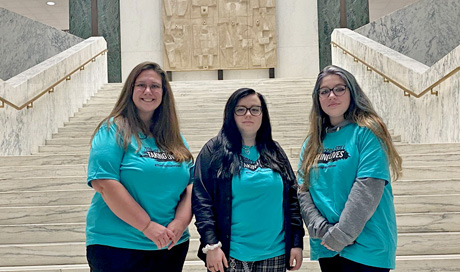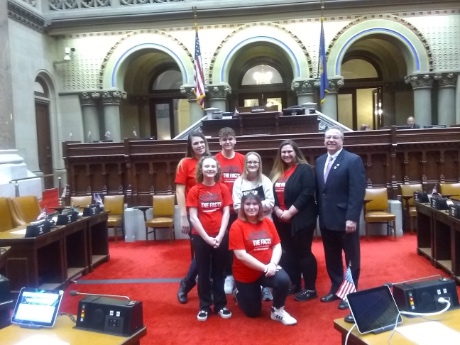Batavia students meet with legislators in Albany about tobacco use among state's youth

Press release:
Leaders and Reality Check youth with Tobacco-Free Genesee, Orleans and Wyoming (TF-GOW), a partner in the New York State Tobacco Control Program (NYS TCP), recently met with Senators Robert Ortt, as well as staff members for Senator George Borrello and Members of the Assembly Marjorie Byrnes and Stephen Hawley, at the state Capitol in Albany to discuss efforts to reduce New Yorkers’ tobacco use and smoking-related deaths and disease. Warsaw High School juniors Samantha Werner, Addison Gay and Patrick Langdon; Attica Middle School eighth-grader Trinnity Wheatle; and Batavia Central School students Prudence Favaloro (junior) and Abbigayle Leone (sophomore), shared details of tobacco control progress and areas of continued need since over 28,200 adults New Yorkers still die every year from smoking. They also stressed that funding for the state’s Tobacco Control Program is just 1.6% of the state’s annual tobacco revenue.
The NYS TCP continues to make immense progress in reducing smoking. The average adult smoking rate in New York State is now 12%, or 1.7 million adult New Yorkers smoke, down from more than 23% in 2001, and the youth smoking rate is down to 2.4% from 27.1% in 2000. However, in addition to the over 28,200 adult New Yorkers who still die every year from smoking, another 750,000 suffer from a smoking-related illness. Despite the reduced cigarette smoking rate, 280,000 New York youth currently under the age of 18 will die prematurely from smoking. And, vaping, or e-cigarette use is still dangerously high. Nearly one in four high-school-age youth in New York State vape/use e-cigarettes, the most used tobacco product among youth.
“Ninety percent of adult smokers begin the deadly addiction of smoking as teenagers or earlier,” said Brittany Bozzer, Reality Check Coordinator for TF-GOW. “I’m proud of our youth for their efforts in encouraging their peers to be tobacco-free, standing up to the tobacco industry and its deceptive marketing, and educating elected leaders on the impacts of tobacco product use in their community.”
The NYS TCP promotes an environment open to change
New York State passed several landmark tobacco control laws in 2020, ending the sale of flavored vape products – including menthol vapes– and the sale of tobacco products in pharmacies statewide; prohibiting tobacco coupons and other discounts; and restricting the exterior display of tobacco product ads near schools. Over the past five years, tobacco control partners have assisted public, affordable and market-rate multi-unit property owners transition over 44,000 multi-unit housing units to be free of tobacco smoke for the health and safety of their residents. Also, during that time, Health Systems for a Tobacco-Free New York assisted 163 medical health care organizations and 152 mental health care organizations in implementing processes that ensure every patient is screened and treated for tobacco dependence during their appointment.Smoking rates remain high among certain demographic groups; more work is needed to save New Yorkers’ lives and improve their health
NYS TCP’s policy-driven, cost-effective and evidence-based approaches contributed to a substantial decline in tobacco use. These approaches are now further focused on communities and populations with high tobacco use rates. Throughout New York State, smoking rates remain high among:
- adults who report frequent mental distress at 19.7%,
- adults with less than a high school education, at 19%,
- adults with an annual household income of less than $25,000, at 20%,
- adults enrolled in Medicaid, at 22.9%, and
- adults living with a disability, at 17.4%.
New York State Tobacco Revenue vs. Tobacco Funding
To combat the deadly impact of smoking, the CDC recommends a $203 million annual investment in New York State’s Tobacco Control Program. The state’s investment is $39 million, just 1.6% of the state’s annual tobacco revenue of $2.36 billion. Further, New York State residents’ annual state and federal tax burden from smoking-caused government expenditures is $1,528 per household.New York State’s tobacco revenue is a combination of the annual Master Settlement Agreement (MSA) payment of $737.7 million, and collection of tobacco excise taxes of $1.63 billion. Under the 1998 MSA, tobacco manufacturers are obligated to pay billions of dollars annually to 46 states, five U.S. territories and the District of Columbia in perpetuity as compensation for taxpayer money that had been spent on tobacco-related diseases and loss to local economies. Learn more about The Economic Reality of Tobacco in New York State.
Flavored products, including menthol cigarettes, pose significant risk
For decades, the tobacco industry has used menthol and other sweet, fruity and candy flavors in tobacco products to make them taste better and less harsh on the throat, making them more appealing to youth. Tobacco companies also have heavily marketed menthol cigarettes to the African American and LGBTQIA+ communities, making it more likely that African American and LGBTQIA+ smokers will suffer from smoking-related diseases and death. The reason is simple: Menthol makes it easier to start smoking and harder to quit.Support is available for New Yorkers who want to quit
The New York State Smokers' Quitline is a confidential service for all New York State residents who wish to overcome tobacco use, including e-cigarettes. Free offerings include individualized coaching and assistance with quit-planning from highly trained tobacco treatment specialists, text and online chat support and free shipping of stop-smoking medications such as nicotine patches, nicotine lozenges or nicotine gum for those 18 and older. Residents of all ages may contact the Quitline for support and educational materials. In addition, the Quitline encourages teens and young adults (ages 13-24) to text “DROPTHEVAPE” to 88709 to join “This Is Quitting,” a free texting support program for help with quitting vaping. Visit nysmokefree.com anytime for more information or call 1-866-NY-QUITS (1-866-697-8487) seven days a week, beginning at 9 a.m.Reality Check New York empowers youth to become leaders in their community in exposing what they see as the manipulative and deceptive marketing tactics of the tobacco industry. The organization’s members produce a change in their communities through grassroots mobilization and education. Reality Check in this area is affiliated with Tobacco-Free Genesee, Orleans and Wyoming counties (TF-GOW), a program managed by Roswell Park Comprehensive Cancer Center.
The New York State Department of Health, Bureau of Tobacco Control funds TF-GOW to increase support for New York State’s tobacco-free norm through youth action and community engagement. Efforts are evidence-based, policy-driven, and cost-effective approaches that decrease youth tobacco use, motivate adult smokers to quit, and eliminate exposure to secondhand smoke.
Photo: Submitted photo. Reality Check Coordinator Brittany Bozzer; Abbigayle Leone, a sophomore at Batavia High School; and Prudence Favaloro, a junior at Batavia High School, on the staircase at the New York State Capitol.

